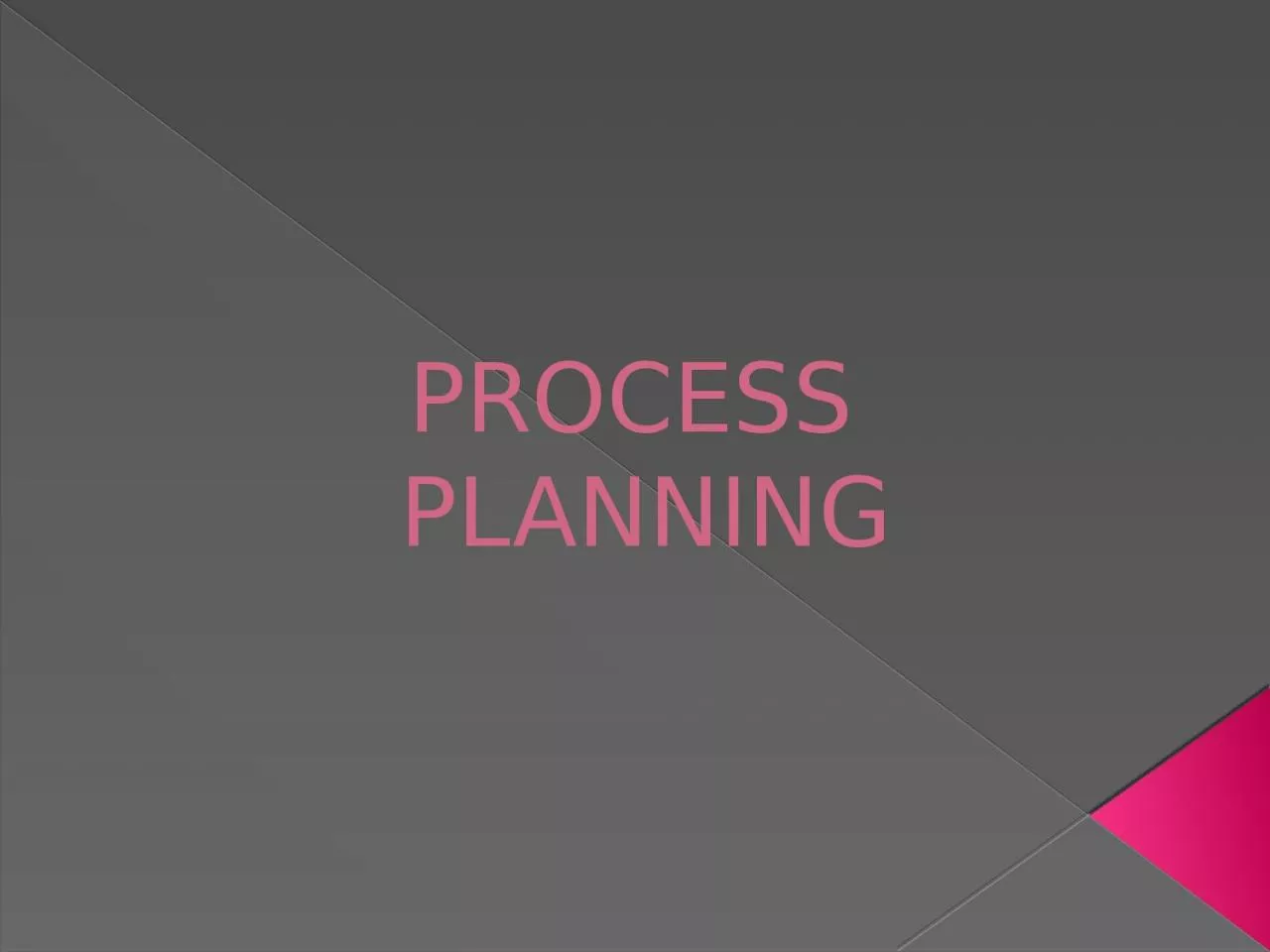

Determining the most appropriate manufacturing processes and the sequence in which they should be performed t o produce a given part or product specified by designed Engineering It can also be defined as ID: 1012273
Download Presentation The PPT/PDF document "PROCESS PLANNING PROCESS PLANNING" is the property of its rightful owner. Permission is granted to download and print the materials on this web site for personal, non-commercial use only, and to display it on your personal computer provided you do not modify the materials and that you retain all copyright notices contained in the materials. By downloading content from our website, you accept the terms of this agreement.
1. PROCESS PLANNING
2. PROCESS PLANNING“ Determining the most appropriate manufacturing processes and the sequence in which they should be performed to produce a given part or product specified by designed Engineering”.It can also be defined as “The systematic determination of the processes by which a product is to be manufactured economically & competitively”.
3. PROCESS PLANNINGThe system or a process responsible for the conversion of raw material in to finished product by the most economical way within the limit of design specifications.The process parameters which is used to convert the part into the final product.Process planning is the intermediate stage between DESIGNING & MANUFACTURING of the product.
4. Defining Process PlanningIn general, the inputs to Process Planning are:Design dataRaw material dataFacilities data (machining data, tooling data, fixture data etc)Quality requirements dataProduction type dataThe output of process planning is the process plan:Process Plan SheetProcess SheetOperation SheetPlanning SheetRoute SheetRoute PlanPart Program
5. FUNCTIONS OF PROCESS PLANNINGProcess Planning has the following important functions:To determine the basic manufacturing process.To determine the sequence of operations.To determine the equipment's and tooling required.
6. Who does Process Planning ?Tradionally, Process Planning is done by manufacturing engineers who are familiar with the particular processes in the factory and are able to read engineering drawings.Based on their Knowledge, skill and experience, they develop the processing steps in the most logical sequence required to make each part.Some details are often delegated to specialists, such as tools designers.
7. PROCESS PLANNING CONSITS OF
8. INFORMATION REQUIRED FOR PPThe following information is needed to develop a process plan.Knowledge of Various manufacturing processes.Engineering drawing of the component.Knowledge of various tooling and fixtures.Relative costs of various processes, tooling and raw materials.Resources available in the factory.Ability to do computations on machining time and cost.Knowledge to use reference books, such as machinability data handbook.
9. PLANNING OF PROCESSES FROM RAW MATERIAL TO FINISHED PRODUCTPart Print AnalysisMake or buy decisionTo Select Basic Manufacturing ProcessTo Determine the Sequence of OperationCombine the OperationsSelection of Machine Tools and EquipmentInspectionMiscellaneous FunctionsPreparation of Operation
10. FACTORS AFFECTING PROCESS PLANNING
11. COMBINED OPERATIONSThe cost of processing can be reduced by eliminating unnecessary operations.This can be achieved in number of ways and are accomplished through proper planning. Operations can be performed in two ways:By SimulationBy Integration
12. By Simulation Simulation involves those combinations where two or more elements of an operation, or two or more operations are performed at the same time.Example: series of hole to be drilled simultaneously using a multiple spindle drill press. Cuter are specially designed.
13. By IntegrationWhere several individual elements of an operation or group of operations are combined in succession but not simultaneously. Example: Taping is done after drilling hole on the same set up by just changing the tool.
14. ADVANTAGES OF COMBINED OPERATIONSImproved accuracyReduced labor costReduced plant fixed costLess tooling requiredLess handling required Fewer setupsSmaller in process inventoryLess scrapFewer inspection points required
15. DISADVANTAGES OF COMBINED OPERATIONSMaintaining tool accuracyPossible higher tool costsMaintaining dimensions for several baselinesMore costly setups Sometimes scrap is increasedCompromises on operational speedChip disposal
16. INSPECTIONQuality related in-process inspection is an essential part of quality control in manufacturing. It includes measuring, examining or testing one or more characteristics of a product or process.Inspection includes separation of defective parts from the non-defective parts.
17. TYPES OF INSPECTION
18. DETERMINATION OF INSPECTION STAGESQuality inspection serves three main purposes:Identification of the problem.Preventing its occurrence.Elimination of the problem.Type of production system.Type of layout.Type of machine used.
19. PURPOSE OF INSPECTIONTo distinguish good lots from bad lots.To distinguish good pieces from bad pieces.To determine if the process is changing.To rate quality of product.To rate accuracy of inspectors.To measure precision of instruments.To secure products design information.
20. STAGES OF INSPECTIONInspection of incoming material.Inspection during the manufacturing process.Inspection of Production processes.Inspection of finished goods when it is completely manufactured.Inspection of the product before delivery, if material is stored from long time.
21.